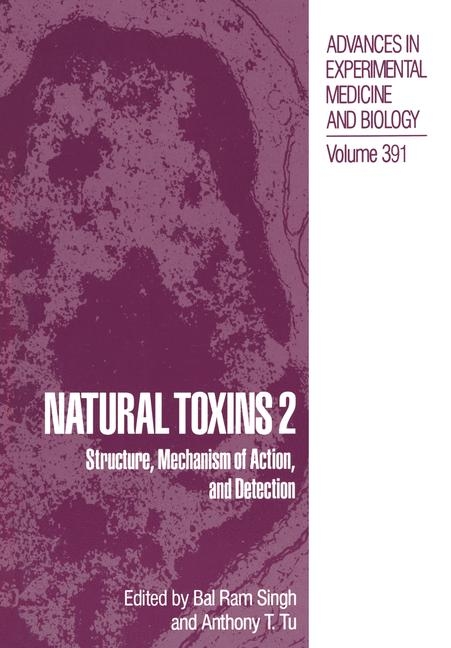
Natural Toxins 2
Kluwer Academic/Plenum Publishers (Verlag)
978-0-306-45289-5 (ISBN)
- Titel ist leider vergriffen;
keine Neuauflage - Artikel merken
From beach encounters, aquaculture perils, and processed-food poisoning to snake bites and biological warfare, natural toxins seem never to be far from the public's sight. A better understanding of toxins in terms of their origin, structure, structure-function relation- ships, mechanism of action, and detection and diagnosis is of utmost importance to human and animal food safety, nutrition, and health. In addition, it is now clear that many of the toxins can be used as scientific tools to explore the molecular mechanism of several biological processes, be it a mechanism involved in the function of membrane channels, exocytosis, or cytotoxicity. Several of the natural toxins have also been approved as therapeutic drugs, which has made them of interest to several pharmaceutical companies. For example, botulinum neurotoxins, which have been used in studies in the field of neurobiology, have also been used directly as therapeutic drugs against several neuromus- cular diseases, such as strabismus and blepherospasm. Toxins in combination with modem biotechnological approaches are also being investigated for their potential use against certain deadly medical problems. For example, a combination of plant toxin ricin and antibodies is being developed for the treatment of tumors. The great potential of natural toxins has attracted scientists of varying backgrounds-pure chemists to cancer biologists-to the study of fundamental aspects of the actions of these toxins.
Overviews of Toxins: Marine Natural Products: Diversity in Molecular Structure and Bioactivity; P.A. Scheuer Plant Toxins: The Essence of Diversity and a Challenge to Research; G.D. Manners Overview of Snake Venom Chemistry; A.T. Tu Critical Aspects of Bacterial Protein Toxins; B.R. Singh Origin, Structure, and Function: Structure and Function of Cobra Neurotoxin; C.C. Yang Structure and Function of Cobra Venom Factor: The Complementactivating Protein in Cobra Venom; C.V. Vogel, et al. A Case Study of Cardiotoxin III from the Taiwan Cobra (Naja naja atra): Solution Structure and Other Physical Properties; T.K.S. Kumar, et al. The Staphylococcal and Streptococcal Pyrogenic Toxin Family; G.A. Bohach, et al. Primary Structural Motifs of Conus Peptides; L.J. Cruj Hymenoptera Venom Proteins; D.R. Hoffman Mechanism of Action: Mechanism of Action of Clostridium perfringens Enterotoxins; N. Sugimoto, et al. Binding Proteins of Synaptic Membranes for Certain Neurotoxic Phospholipase A2; M.C. Tzeng, et al. Pyrularia Thionin: Physical Properties, Binding to Phospholipid Bilayers and Cellular Responses; L. Vernon The Chemistry and Biological Activities of Natural Products AALtoxinand the Fumonisins; H.K. Abbas, et al. New Aspects of Amanitin and Phalloidin Poisoning; H. Faulstich, T. Wieland Actions of Banana Tree Extract on Smooth and Cardiac Muscles and in the Anesthetized Rat; Y.N. Singh, et al. The Early Expression of Myotoxicity and Localization of the Binding Sites of Notexin in the Soleus Muscle of the Rat; R.W. Dixon, J.B. Harris Fumonisin BI: Immunological Effects: The Influence of F BI to the Early Stage of Immune Response; E.A. Martinova Scientific and Medical Tools: K252a and Staursporine Fungal Alkaloid Toxins as Prototype of Neurotropic Drugs; P. Lazarovici, et al. Structure and Experimental Uses of Arthropod Venom Proteins; D. Jones Metamorphoses of a Conotoxin; E. Zlotkin, et al. Purification and Characterization of Nerve Growth Factors (NGFs) from the Snake Venoms; K. Hayashi, et al. Snake Venoms as Probesto Study the Kinetics of Formation and Architecture of Fibrin Network Structure; A. Azhar, et al. Fribolase: An Active Thrombolytic Enzyme in Arterial and Venomous Thrombosis Model Systems; F.S. Markland Detection, Diagnostics, and Therapy: Mass Spectrometric Investigations on Proteinaceous Toxins and Antibodies T. Krishnamurthy, et al. Detection of Staphylococcal Toxins; M.S. Bergdoll Detection of Clostridium botulinum Neurotoxins; C.L. Hatheway, J.L. Ferreira Detection of Botulinum Neurotoxins Using Optical Fiberbased Biosensor; B.R. Singh, M.A. Silvia Comparative Studies of Antisera against Different Toxins; N. Nascimento, et al. New Approaches in Antivenom Therapy; V. Choumet, et al. Distribution of Domoic Acid in Seaweeds Occurring in Kagoshima, Southern Japan; T. Noguchi 12 additional articles. Index.
| Erscheint lt. Verlag | 31.5.1996 |
|---|---|
| Zusatzinfo | 548 p. |
| Verlagsort | New York |
| Sprache | englisch |
| Gewicht | 1140 g |
| Themenwelt | Studium ► 2. Studienabschnitt (Klinik) ► Pharmakologie / Toxikologie |
| Naturwissenschaften ► Biologie ► Biochemie | |
| ISBN-10 | 0-306-45289-8 / 0306452898 |
| ISBN-13 | 978-0-306-45289-5 / 9780306452895 |
| Zustand | Neuware |
| Haben Sie eine Frage zum Produkt? |
aus dem Bereich


